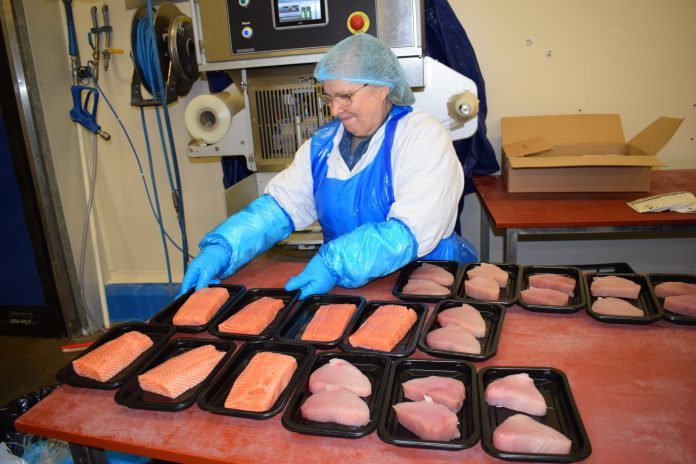Smit Vis is dedicated fish supplier for Dutch horeca and foodservice wholesaler Sligro. Salmon accounts for 20 percent of the company’s production.
Smit Vis, located in Veghel, is the largest fish supplier for the catering and wholesale trade in the Netherlands. It has national coverage and is represented in various Sligro self-service locations with fresh fish departments.

Sligro Food Goup consists of 50 self service horeca wholesale departments, professional caterer Van Hoeckel and supermarket chain Emté, with a presence at 131 locations.
The purchase and processing of fresh fish takes place at the head office of Smit Vis in Veghel. The production floor is over 2500 m². The company employs 40 people.
Asian restaurant segment
“All our salmon, fresh, frozen and smoked, is supplied daily by Rodé Vis from Urk,” says commercial manager Erwin van den Oever.
Fresh salmon accounts for 50 percent of the volume, frozen 15 percent and smoked products 35 percent, Van den Oever continues.
“The large amount of fresh salmon is due to our volume in the Asian restaurant segment in the Netherlands. The number of Asian restaurants has grown rapidly in recent years. Mainly ‘All you can eat’ and sushi places, with Chinese owners.”
 Salmon is an important product for this type of restaurant, Van den Oever explains. “They serve a lot of fresh-made sushi and other salmon dishes. Smoked salmon is usually also on the menu.”
Salmon is an important product for this type of restaurant, Van den Oever explains. “They serve a lot of fresh-made sushi and other salmon dishes. Smoked salmon is usually also on the menu.”
The Asian restaurants mostly order whole salmon, says Van den Oever.
“French and Dutch style restaurants also use a lot of fresh salmon, and Italian restaurants too, on a smaller scale, but they mostly order fillets.”
Norway Mid or North
The Chinese restaurant owners prefer their salmon not too fatty. “When we first started supplying them, we looked into the Japanese preference for sushi salmon. Japanese chefs like to work with very fatty salmon, from the far North of Norway. But it turned out the Chinese chefs prefer a much less fatty salmon, that they can slice very thinly. We now order that kind of salmon from Norway Mid.”
“We usually prefer salmon from the far North of Norway. That area has fewer problems with salmon lice, and the treatment for lice can influence the quality of the fish,” Erwin van den Oever continues. “The warm water treatment, for example, is shown by the color of the gills, and affects the color of the mucus layer. Of course, the customer is king, and we are able to provide any kind of salmon, through our supplier Rodé Vis, who has never let us down in all our fifteen years of cooperation.”
Smoked salmon is very popular with caterers for food service, says Van den Oever.
“Salmon is a very popular fish in the Netherlands. Smoked salmon is generally liked by almost everybody, as opposed to for example oysters, that are only liked by a small group of consumers. Salmon is recognizable, and is a familiar taste that most people like.”
 Smit Vis and Sligro organize monthly boat tours in the Dutch province of Zeeland for their customers, to stimulate growth. “We do this in cooperation with our shellfish producers from Yerseke. We take a group of chefs and restaurant owners to the mussel banks, combined with tastings of all the products available at Sligro, and workshops in fish filleting. Salmon is always part of the program, because it’s a very important product for restaurants.”
Smit Vis and Sligro organize monthly boat tours in the Dutch province of Zeeland for their customers, to stimulate growth. “We do this in cooperation with our shellfish producers from Yerseke. We take a group of chefs and restaurant owners to the mussel banks, combined with tastings of all the products available at Sligro, and workshops in fish filleting. Salmon is always part of the program, because it’s a very important product for restaurants.”
Product development
Together with Rodé, and Sligro partner Culivers, Smit Vis develops products focussed on foodservice and meals.
“For example salmon burgers and rouleaux with salmon and eel, for the holiday season. We also supply Sligro with sushi, in cooperation with our local sushi company Beijching,” says Van den Oever. For the following year, he expects a healthy growth in volume, including salmon.
“The last couple of years we have seen a growth of 10 percent, and I expect no less for next year.”

